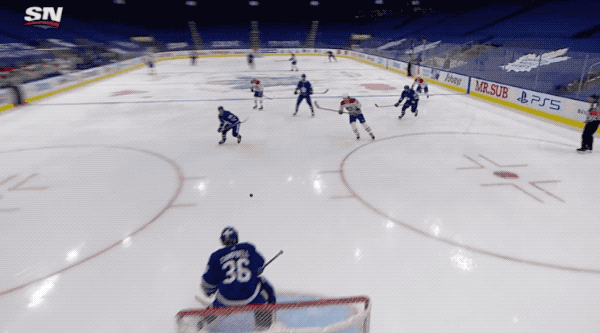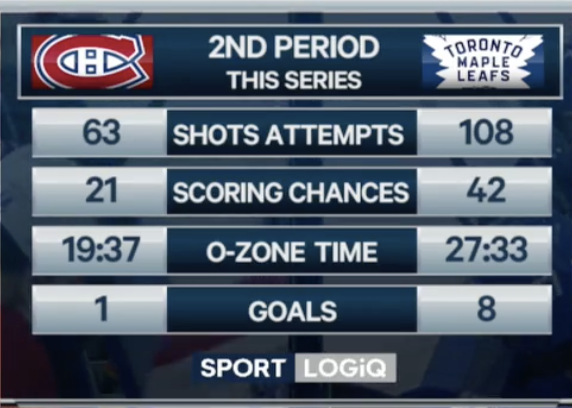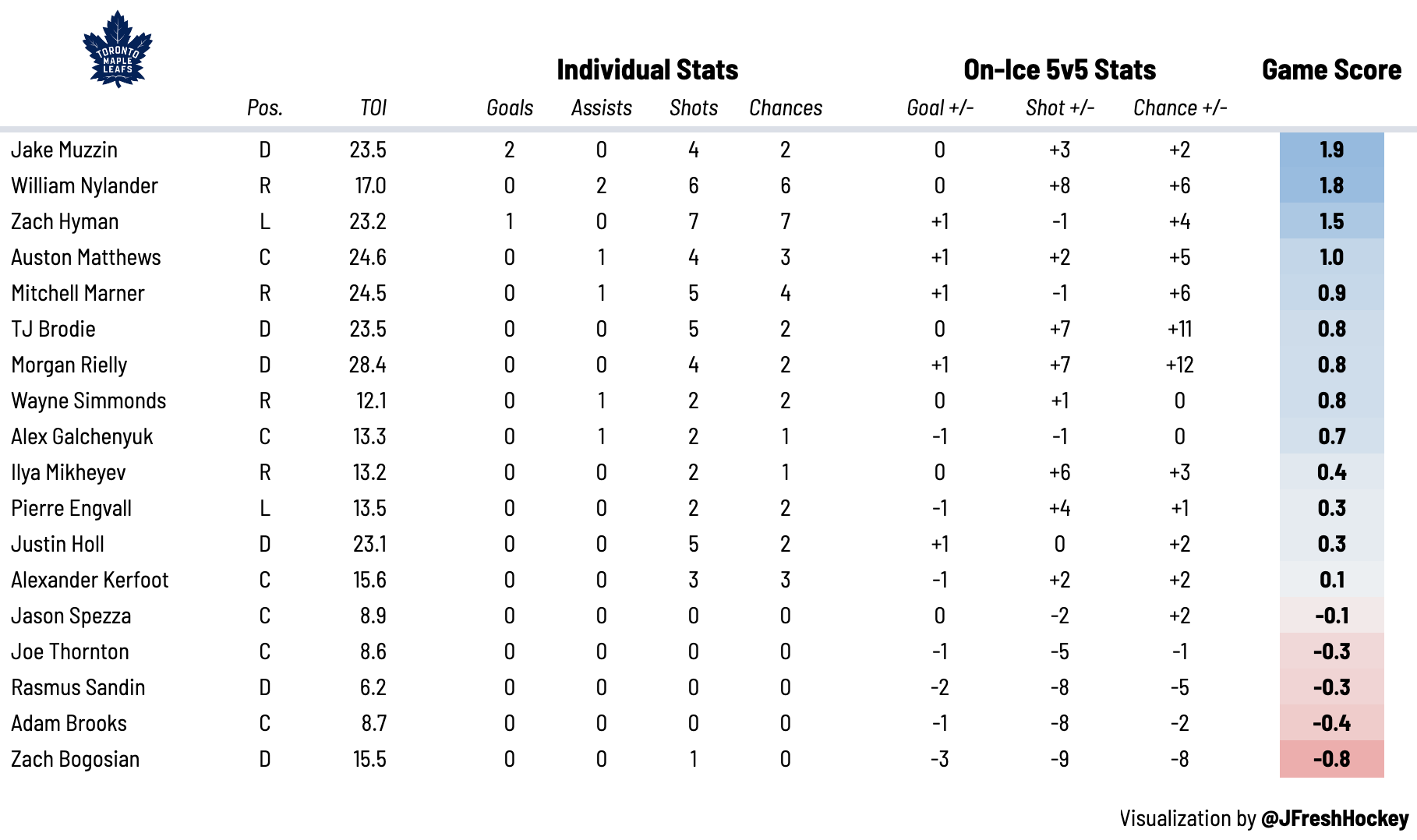That’s what happens when you turn the puck over.
The more I got into hockey analytics, the more I tended to value some of the high-risk, high-reward players, convincing myself the pros outweighed the cons with the Jake Gardiners of the world when you aggregate their results over a large sample. I still lean that way, but watching a game like this is a good reminder of how bad turnovers can cost you goals against in a hurry.
Toronto ended up losing 4-3 to Montreal in overtime despite controlling the majority of scoring chances. The reason for that? Bad. Turnovers.
You’ve probably already seen the replays countless times now of Rasmus Sandin giving the puck away on the two goals he was responsible for, not to mention Alex Galchenyuk’s blind pass in overtime leading to a 2-on-0 breakaway goal for Nick Suzuki.
I don’t need to tell you those were poor decisions.
What I would like to do is break down some of the other nuances in this game. There were some interesting coaching decisions from both sides, a few tactical things to keep an eye on, and oh yeah, not many penalties. It just so happened there were only two infractions in this game, but honestly, referee discourse has reached the point of exhaustion for me by now.
Let’s try our best to rationally break down what I’m sure was an emotional night for all of you. Despite my attempts to analyze Leafs games objectively, I found myself staring at the ceiling after that inexplicable turnover in overtime. I’ve taken some deep breaths, meditated for a few minutes, re-watched some of the footage, and gone through the data.
Still not sure if I’m “ready” to do this properly, but here goes nothing. It’s time for some postgame #analysis!
Noteworthy Performances
I hate to be a Debbie Downer here, but Rasmus Sandin is probably the first player we should mention. He was responsible for two goals against. The first one was a mistake we’ve seen him make in the past, failing to get the puck out of the zone along the right wall when he’s being pressured.
His teammate could’ve done a better job receiving the pass, but the ensuing 2-on-1 goal is still more on Sandin. There was no debate with the following turnover where he lost the puck behind the net to Jesperi Kotkaniemi and fell down when he tried to get it back.
This just wasn’t Sandin’s night, and his coaches recognized that, only giving him a couple more shifts afterward. He ended the game with 6:11 of ice time, the lowest among all Leafs, including the fourth liners.
I can understand why Sheldon Keefe wanted to go back to Sandin in Game 5, considering he has more offensive upside than Travis Dermott. The counterargument is that Dermott’s best attribute — gapping up in the neutral zone and defending the rush — is the one that helps limit what Montreal has been having the most success with this series.
What's tough for Dermott and Leafs is…what do you expect from your 6th D? Dermott was essentially perfect in G4, but that simplicity isn't impressive. Sandin can do MORE. I'm sure they wanna keep him in, his play warranted it, but ¯_(ツ)_/¯. These are his touches from Game 4. pic.twitter.com/ianuURpaIq
— Justin Bourne (@jtbourne) May 27, 2021
It feels nice to not be the only one screaming for Dermott to get more minutes for once. Speaking of ice time.
William Nylander was Toronto’s most dangerous forward on the ice by far in Game 5. You could make a good case that’s also been true for the rest of this series, leading the Leafs in playoff goals and points.
He played 16:36 in regulation, 17:01 if we count his one shift in overtime.
Remember when Mike Babcock said “that’s too much” after Leo Komarov played over 24 minutes in a regular-season game? Well, that’s not enough for Nylander — not nearly enough considering how well he’s been playing lately.
This has been an ongoing issue throughout the season, with the Tavares-Nylander line failing to receive minutes in line with their impact. The Swedish winger averaged only 16:36 in the regular season — his exact amount of ice time in Game 5 right down to the second.
For reference, here’s how often he’s played in each of the five games in this series.
- 16:40 in Game 1
- 16:40 in Game 2
- 16:47 in Game 3
- 14:34 in Game 4
- 17:01 in Game 5 (16:36 in regulation)
I could go into detail about some of the high-skilled plays Nylander was making with speed off the rush to break down Montreal’s defense and generate quality chances, but honestly, do I really need to do that? I’m guessing you watched the game and saw it too.
The most frustrating aspect is that Keefe refuses to give Nylander more ice time, playing him on PP2 while arguing the “matchups” at 5v5 are preventing him from getting any more minutes. Frankly, if it were Babcock doing this, we’d all be screaming from the rooftops right now.
You’re allowed to believe in the underlying philosophy behind what Kyle Dubas & Keefe are doing, but still disagree with some of the decisions that are being made. Some might call it critical thinking.
Now, you’re probably aware that I’ve been highly critical of Morgan Rielly this season, which is why I need to admit when he has a standout performance like in Game 5. He tilted the ice better than any of his teammates, with Toronto out-chancing Montreal 16-4 when Rielly was on the ice at 5v5.
That’s about as dominant as it gets. He was achieving those results by pushing play up the ice every time he got the puck, using his speed to blow by his man in transition and create rush opportunities. Rielly and Nylander were the two best at this in Game 5, and it showed in their ability to generate good looks for the Leafs offensively.
I’d also like to point out that Rielly’s gap control has looked much better in these playoffs. There’s obviously the Suzuki goal that’s probably burned into your brain, but there are also a bunch of 1v1 rushes where Rielly stays within a stick-length at the blueline, patiently waits until it’s the right time to attack, and breaks up the play.
It’s an area of his game that’s frustrated me the most over the last few years, so it’s only fair I give him credit when he cleans up some of those issues in high-leverage games.
Jake Muzzin was another defenseman of note in this game, scoring not one but two goals to help the Leafs force overtime after falling behind 3-0. He let go of a bomb on the power play, reminding us that he’s a surprisingly legitimate shot threat at the top of PP2.
Muzzin also jumped up in the rush to deflect a shot from Galchenyuk in the third period, providing big-time value offensively from a defenseman who’s typically more well-known for his impact on the other side of the puck. It’s times like these when I like to remind myself that Muzzin has actually been Toronto’s 5v5 points per 60 leader among defensemen over the past two seasons. He’s sneaky good on offense.
I’d also like to discuss Zach Hyman‘s strong play at 5v5. Unfortunately for Toronto, he was the best player on a line with Auston Matthews and Mitch Marner. The stars didn’t have their best game, although Hyman stepped up with a few brilliant backdoor passes off the rush, nearly setting up both of his linemates for goals on a redirect in front.
For any of us who have been watching Hyman’s game evolve over the years, I still marvel at him carrying the puck from DZ to OZ, making a play to get around the defender, and then looking for a high-percentage play offensively. That wasn’t his game when he entered the league, but he’s found a way to use his speed and strength to get the puck up the ice quickly and even create some high-skill plays in transition.
His next contract is still one that fascinates me. You can’t help but watch him this year at 5v5 and tell yourself, “This is a player the Leafs can’t afford to let walk.”
Last and sadly least, Joe Thornton just didn’t have it in Game 5. He was the one who failed to receive Sandin’s pass on Montreal’s first goal. He was also given PP1 time in the bumper spot, again, and unsurprisingly the reason Toronto turned the puck over in-zone with the man advantage.
The Big Mistakes
You’re already thinking about them, so we might as well dive into the infamous turnovers in our “video room” section here. Let’s start with the first goal against.
Kevin Bieksa already did a better job outlining this than I ever could, but I’ll give it a whirl anyways. Corey Perry’s physical presence on the forecheck is what forces Sandin to rush his decision making, putting the puck in Thornton’s feet. There’s an argument to be made that Thornton can still get it out, but when the pass isn’t on your tape, that’s a pretty difficult play.
For fun, here’s a look at an almost identical turnover Sandin made earlier this season.
It’s not the same play, but it’s in the same spot. It’s hard for left-handed defensemen to exit the defensive zone from the right wall in the DZ since you’re on your wrong side, exposing the puck to the middle of the ice instead of protecting it with your body along the boards on your strong side.
That added element of risk was enough for Sandin to turn the puck over against Montreal in the past, and it burned him again in Game 5. This isn’t to say Sandin can’t make plays out of his own end on the right side — he’s been making those passes at every level — he just needs to be more cautious of how vulnerable he is when attempting to do so.
When you don’t get that puck out, it leads to a panic 2-on-1, and a lot of the times, that puck ends up in the back of your net. Maybe next time, focus on making the simple play up the wall to an open teammate instead of trying to do too much.
Now let’s take a look at Sandin’s second blunder in the defensive zone.
He starts off making the right play, beating Montreal’s first forechecker to the loose puck and settling things down behind his net. He un-settles it by banking his pass off of Jesperi Kotkaniemi’s skate, fails to win the ensuing 50-50 battle, loses his balance, and let’s face it, loses his confidence as that puck crosses the goal line.
What’s frustrating about this play is that Sandin has been the team’s most efficient puck-mover at the NHL level when you look at his controlled zone exit numbers, albeit in sheltered minutes. He hasn’t been known for making mistakes like these throughout his professional hockey playing career in Sweden, the AHL, and now the NHL.
It’s a bang-bang play in real-time, but Sandin knows he needs to get that puck moving to an open teammate before the forechecker can force a turnover right by the net. When you lose possession there, it’s a high-percentage chance for your opponent.
Finally, let’s finish up this section with the Leafiest possible outcome in overtime.
Alex Kerfoot rims the puck around the boards and the defenseman, Zach Bogosian, activates into the play so his team can maintain possession. That’s pretty standard stuff in the modern game of hockey.
Galchenyuk goes to cover for Bogosian at the point, which he’s supposed to as the F3. The problem is when he makes the blind pass to the middle, leading to a 2-on-0 breakaway that Jack Campbell insists he “should have had.” No, you shouldn’t have, Soupy. It was literally a 2-on-0.
This is a tough one for Galchenyuk because his best plays over the last couple games have been his one-touch passes to open teammates in the middle of the ice. It’s those type of high-risk plays that have helped get Kerfoot and Nylander into open ice, especially when Galchenyuk makes these types of passes in the neutral zone.
Much like Sandin, though, there’s a cost-benefit analysis you have to make here as a player. If the risk is worth the reward, you go for it. The problem is that even if Galchenyuk completes that pass above, it’s going to a defenseman at the point. You’re not gaining too much from that, whereas a turnover could — and did — cost you the game.
Keefe’s Lineup Blender
We mentioned that Sandin basically didn’t play after turning the puck over for a second straight goal against, which forced Keefe to make some adjustments on the fly with five defensemen. Courtesy of MoneyPuck.com, here’s a look at how the 5v5 minutes played out on the blueline.
- 16:28 of Rielly-Brodie
- 15:35 of Muzzin-Holl
- 6:49 of Rielly-Holl
- 4:44 of Muzzin-Bogosian
- 4:16 of Sandin-Bogosian
- 3:50 of Rielly Bogosian
There were a couple of other minor quirks, including a Rielly-Sandin pair that got an OZ start and post-PP shift, but the most interesting aspect to me was Rielly getting some more minutes alongside Justin Holl. They did well in those minutes, as did the Muzzin-Bogosian pair in some matchup minutes.
I’m not sure if those are pairings we’ll see again in the playoffs, but it’s nice to know you have options as a coaching staff.
We saw Keefe explore some of those options with his forward group throughout Game 5, finding some creative ways to get Nylander on the ice for a few more shifts. He ended the first period alongside Matthews-Marner, getting himself a rush chance that beat Carey Price but just missed wide.
Another combination we saw was the Mikheyev-Engvall-Nylander trio. I can see the logic behind it; get Nylander an extra shift alongside two guys who will help him get the puck back. This is a good opportunity to acknowledge that Keefe was clearly trying to consciously get Nylander a few more shifts while he was buzzing.
My argument is that Keefe needs to do much more in that regard. Whenever an NHL head coach gives a star player too few minutes in a playoff game, the common excuse is that Player X takes short shifts. Babcock said this about Matthews in that infamous Game 7. If that’s the case, it’s your job as the coach to make sure you find other ways to get that player the minutes they need to maximize your team’s chances of winning.
Call me crazy, but putting your five best players on PP1 might be one way to help accomplish that.
The Numbers
The biggest trend we’ve noticed in this series has been Toronto’s second-period dominance.
Terrific 1st period by the Canadiens. Can they continue to apply pressure or will the Maple Leafs tilt the ice as they have all series in the 2nd? Graphic from @NHLonNBCSports pre-game earlier tonight… pic.twitter.com/hMyak3YJPE
— Mike Kelly (@MikeKellyNHL) May 27, 2021
The broadcast showed us another similar graphic, breaking down a few key metrics that demonstrate how puck-dominant the Leafs have been in the second frame.
The goals are a product of a bit of puck luck, but they’ve been doubling Montreal in scoring chances pretty consistently. Even in this game, Toronto got out to a brutal start in the first period and still managed to out-chance the Canadiens 10-6 in the second.
Something I’ve been thinking about is how the long change naturally benefits the superior possession team because it’s harder for the team without the puck to get fresh legs. What’s interesting is that goal rates also go up in the second, which is why I’d like to see the NHL give all three periods the long change. Goals are good for this sport.
I don’t expect the NHL to make smart rule changes any time soon, but I do expect Toronto to continue this trend of second-period superiority. Their ability to exploit some of the extra space that becomes available is really giving Montreal a tough time, even in a game like this where the Habs were clearly the better team to kick things off.
Before we get out of here, it’s tradition for me to post the following graphic.
Individually, Nylander and Hyman were the clear drivers offensively for the Leafs on Thursday night. At the team level, it was nice to see the Rielly pair control the run of play at even strength, spending the majority of their shifts creating chances in the offensive zone.
On the flip-side of that equation, Toronto’s fourth line forwards generated a combined zero shots at the net between the three of them, which is why they each played under nine minutes.
Who comes out?
Looking ahead to Game 6, it’s the natural question for most Leafs fans: Who comes out of the lineup? I think most of us expect Dermott to draw in for Sandin after that nightmare game, especially considering how well Dermott limited rush opportunities and efficiently started the breakout at 5v5 in Game 4.
The next question you have to ask yourself is what you’re doing with that fourth line. Adam Brooks is the furthest thing from a lock on this Leafs roster, so it wouldn’t be shocking to see a Riley Nash draw in to help get him more acclimatized to things. After all, he did “do his job” in the two games he played this postseason with respect to slowing the game down and limiting scoring chances for both teams at 5v5. It’s also possible Nick Foligno returns at some point from his injury.
My final query is whether or not the Leafs are ready to take Thornton out of the lineup. They wouldn’t rest him in the regular season, even when he was clearly going through it in the dog days of February and March. Actions speak louder than words, so I wouldn’t expect him to come out of the lineup, but based on his recent performance, I’d be curious to see if you could get more from someone else in that roster spot.
I love Jumbo as much as the next guy — he seems like a genuinely awesome human being — but when a multi-billion dollar organization is trying to find every edge they can to win hockey games, you have to play your 12 best forwards.
If anything, having him there gives Keefe the opportunity to throw him on PP1, where he’s clearly been a liability. The Leafs have been hesitant to sit veterans in the past — see: Marleau, Patrick — so I’m not sure how likely it is this will happen. Realistically, though, the team needs to be having a tough conversation behind closed doors.







































